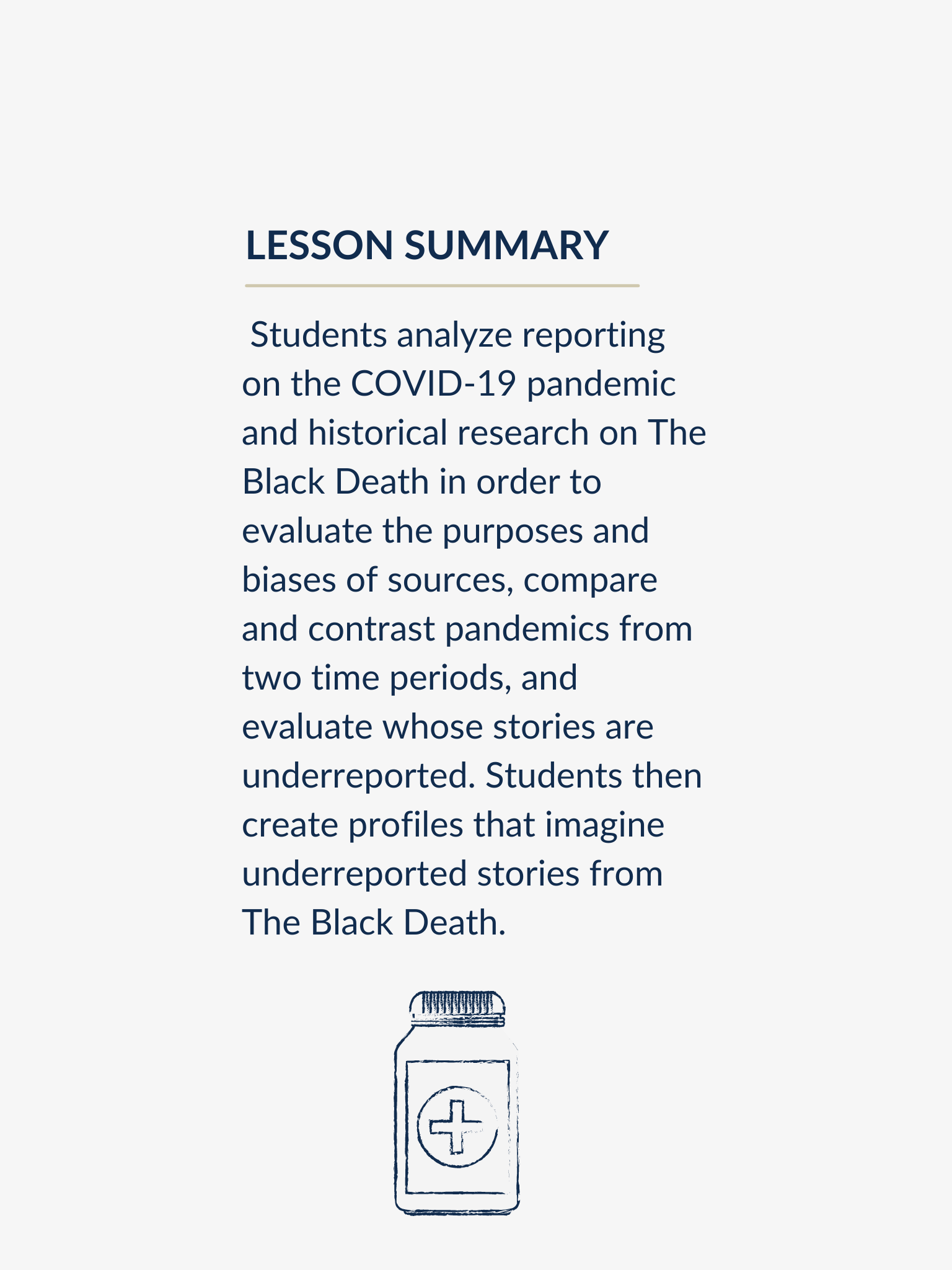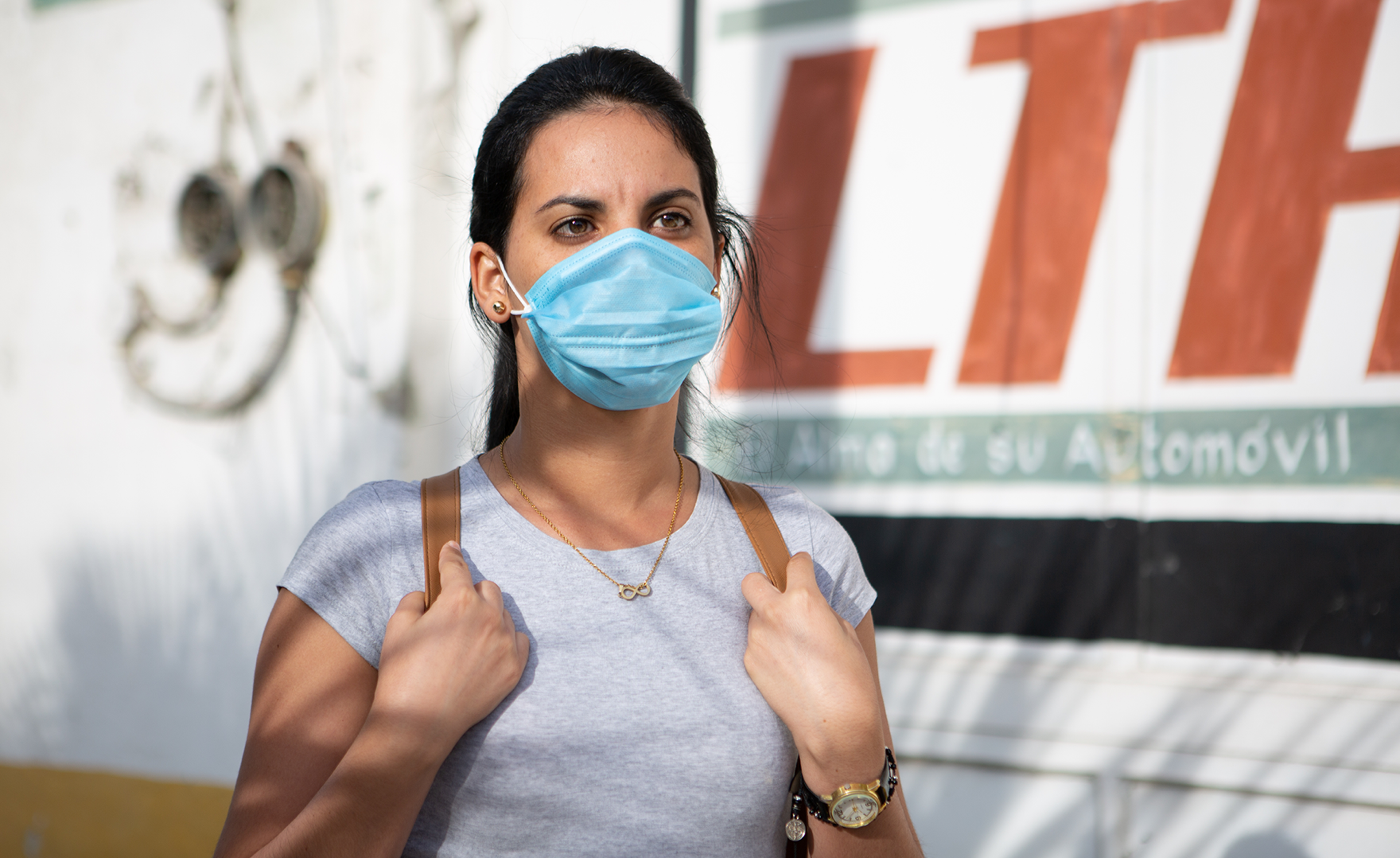This unit was created by Adam Guerrero, a history teacher at Crowley Independent School District in Crowley, Texas, as part of the fall 2020 Pulitzer Center Teacher Fellowship program on Media, Misinformation, and the Pandemic. It is designed for facilitation across approximately three 50-minute class periods.
Unit Objectives
- Analyze a series of historical 14th century sources on the Black Death for their author, bias, and purpose in order to evaluate which voices are not present in the documents.
- Analyze contemporary sources surrounding the COVID-19 pandemic for the above-mentioned elements and seek to determine similarities and differences between the sources.
- Analyze underreported news stories on the coronavirus pandemic, and evaluate what stories might have been underreported during the Black Death.
- Apply interview skills to the composition of original interviews that highlight underreported stories from The Black Death.
Unit Overview:
When a pandemic strikes a society, it is often the marginalized who suffer the most in a societal system that fosters little to no support economically, politically, or socially to those whose voices are often lost amidst the chaos. When reviewing the sources documenting a pandemic, a common theme occurs: the narrative is mostly controlled by those in power. Therefore, the following questions must be asked:
- How does that impact how a pandemic is addressed?
- How is a pandemic remembered in scholarship and human memory?
- How might lack of representation in media, and historical documentation of a pandemic cause further detriment upon marginalized communities?
The Bubonic Plague of the 14th century ravaged much of Afro-Eurasia, causing great devastation upon the population. During this tragic event, sources that controlled the narrative of the period often documented the experiences of certain groups of impoverished and marginalized communities in ways that were negative and inaccurate. Such misinformation and rumors often traveled alongside the plague, further harming already oppressed communities.
Although the Bubonic Plague ended more than six hundred years ago, there is much that a student of history could learn from analyzing the Black Death and comparing it to the modern COVID-19 pandemic. In the present, media sources often continue to leave out the voices of the marginalized members of modern day societies. Misinformation and rumors have also been part of the coverage of the current pandemic, and that misinformation has again led to a growing concern for the wellbeing of marginalized groups within society.
This lesson aims to have students analyze sources from the period of the Black Death in Medieval Europe and compare them to coverage of the modern COVID-19 pandemic. They will evaluate whose stories are being told, and whose stories are being ignored. They will also seek to understand the credibility of sources and evaluate the inherent bias within each source. Throughout this analysis, students will practice their historical skills of comparing, contrasting, and analyzing the purposes of sources. They will also evaluate who is documented as having agency during a pandemic and whose voices are lost.
Performance Tasks
- Draft outlines for underreported stories that students can investigate in their own communities
- Document-based questions (DBQs) to track students' evaluations of reporting on the COVID-19 pandemic and historical research on The Black Death
- Original profiles and mock interviews that capture underreported stories from the period of The Black Death
Unit Plan
Complete 3-day unit plan including warm up activities, extension activities, links to reporting explored as part of each lesson, and graphic organizers for students to track their work.
Click here for a google form that can be used to evaluate student learning at the end of the unit.
Performance Task
- After lesson 1, students brainstorm ideas for underreported stories they can investigate in their communities using pages 9-20 of this graphic organizer.
- Here is an example from a student in Crowley, TX who completed this task in fall 2020.
- After lesson 2, students compare and contrast reporting on The Black Death and The COVID-19 pandemic using the "Evaluating Documentation of The Black Death and COVID-19" graphic organizer
- Here are examples from two students in Crowley, TX who completed this task in fall 2020: Student example 1 and student example 2
- After lesson 3, students will apply what they have learned from the previous lessons by identifying an under-represented person from the Black Death in Medieval Europe and conducting a mock profile of that person. The final profile can be hosted in the "Reporting During The Black Dealth" graphic organizer.
- Here are examples from students in Crowley, TX who completed this task in fall 2020: Student example 1, student example 2, student example 3, student example 4, and student example 5.
Assessment/Evaluation
At the conclusion of the unit, students reflect on their learning using this google form, which can be copied and reused in your class
Samples of Student Work
Here are examples of how students who participated in the unit in fall 2020 from Crowly, TX responded at the end of the unit.
Standards:
TEKS WH.4F: Explain how the Crusades, the Black Death, and the Hundred Years’ War contributed to the end of Medieval Europe.
TEKS WH.28B: Explain how historians analyze sources for frame of reference, historical context, and point of view to interpret historical events
TEKS WH.28C: Analyze primary and secondary sources to determine frame of reference, historical context, and point of view
TEKS WH.28D: Evaluate the validity of a source based on bias, corroboration with other sources, and information about the author
Optional Resources for Lesson 2:
- "Tucker Carlson: We were lied to about coronavirus and the mass lockdowns. Here's the proof" by Tucker Carlson for Fox News
- "Trump to 'suspend immigration into the United States' by executive order amid coronavirus" by Gregg Re for Fox News
- "New York Threatens Orthodox Jewish Areas With Lockdown Over Virus" by Liam Stack and Joseph Goldstein for The New York Times
- Other sources in "The Black Death," which was translated and edited by Rosemary Horrox:
Optional Resource for Lesson 3:
- Pulitzer Center lesson: Interviewing Techniques for Telling Underreported Stories










